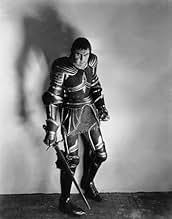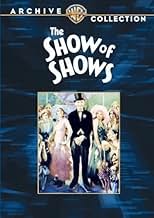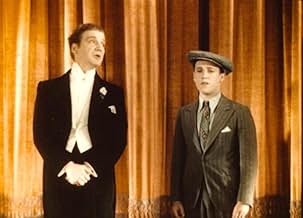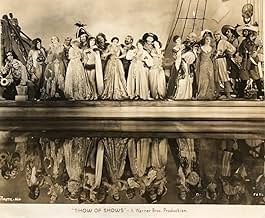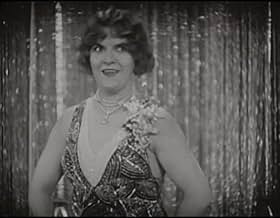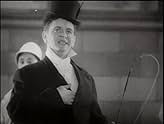Ajouter une intrigue dans votre langueIn 1929, the studio gave the cinema its voice and offered audiences a chance to hear their favorite actors and actresses from the silent-screen era. For the first time, they can be heard in ... Tout lireIn 1929, the studio gave the cinema its voice and offered audiences a chance to hear their favorite actors and actresses from the silent-screen era. For the first time, they can be heard in a gaudy, grandiose musical-comedy revue. But also appearing are actors and actresses from ... Tout lireIn 1929, the studio gave the cinema its voice and offered audiences a chance to hear their favorite actors and actresses from the silent-screen era. For the first time, they can be heard in a gaudy, grandiose musical-comedy revue. But also appearing are actors and actresses from the first 'talkies', stars from Broadway, and, of course, German shepherd Rin-Tin-Tin. Fra... Tout lire
- Réalisation
- Scénario
- Casting principal
- Récompenses
- 2 victoires au total
- Performer in 'Meet My Sister' Number
- (as Mimi Vendrell)
- Joe Burke
- (as Joe Burke)
Avis à la une
Contributing also as a writer, host Frank Fay does a good job. The studio's biggest star at the time was Richard Barthelmess (rising from #8 in 1928 to #7 in 1929 according to the annual Quigley Poll of Box Office stars); he does not sing or dance, preferring to briefly appear as a dignified presenter. The legendary Al Jolson does not appear at all, but Sid Silvers imitates him well. John Barrymore contributes a fine excerpt as "Richard III" from "Henry VI" - rare celluloid from the Shakespearian maestro...
Another highlight is the biggest hit song from the show, "Lady Luck" performed memorably by band-leader Ted Lewis (who took it to #3 on the record charts) and singer-guitarist Nick Lucas (who helped keep Lewis from rising higher by locking down #1 for ten weeks with his "Tip Toe Through the Tulips"). Of the many cover versions, "Singin' in the Bathtub" (a good-natured poke at MGM's "Singin' in the Rain") rose to #10 in a version by Guy and Carmen Lombardo; here, Winnie Lightner contributes a vibrant version.
***** The Show of Shows (11/21/29) John G. Adolfi ~ Frank Fay, Nick Lucas, Winnie Lightner, John Barrymore
In brief, THE SHOW OF SHOWS musical program features: PROLOGUE UNIQUE: Hobart Bosworth as an executioner and HB Warner as the victim in a brief skit set during the French Revolution; THE MILITARY PARADE: lead by Monte Blue and marching and drum playing West Point cadets; FLORADORA GIRLS: Myrna Loy, Marian Nixon, Ben Turpin, Lupino Lane, and many others in 1890s costumes; THE PIRATE NUMBER: featuring Ted Lewis with motion picture pirates including Noah Beery, Tully Marshall, etc.; EIFFEL TOWER: Georges Carpentier; RECITATIONS: Beatrice Lillie, Louise Fazenda, Lloyd Hamilton and Frank Fay, later going into their song, "Your Mother and Mine"; EIGHT SISTER ACT: Hosted by Richard Barthelmess, followed by sisters including Dolores and Helene Costello singing "Meet My Sister," along with Loretta Young and Sally Blane, Sally O'Neil and Molly O'Day, Alice and Marceline Day; Marion Byron and Harriett Lake; and others. Following this number comes a title card that reads INTERMISSION: TEN MINUTES (which is usually eliminated from most TV prints); SINGING IN THE BATHTUB: Winnie Lightner, which concludes with Lightner and Bull Montana singing "You Were Meant for Me"; IRENE BORDONI HERSELF: Bordoni singing "Just an Hour of Love"; Chinese FANTASY: Introduced by Rin-Tin Tin; with Nick Lucas singing "Li-Po-Li" and Myrna Loy dancing (this number now can be seen in its restored two-strip Technicolor); FAY AND SILVERS: Amusing skit with Sid Silvers stepping in and auditioning for a solo spot, showing Frank Fay his own imitation of Al Jolson by singing "Rock-a-Bye Your Baby With a Dixie Melody"; BICYCLE BUILT FOR TWO: Chester Conklin, Douglas Fairbanks Jr., Chester Morris; Gertrude Olmstead, Sally Eilers, among others; BLACK AND WHITE: Introduced by Sid Silvers, danced by chorus girls dressed up in black and white dresses; YOUR LOVE IS ALL THAT I CRAVE: Sung by Frank Fay (he finally got to do his solo); KING RICHARD III: Introduced and recited by John Barrymore; Mexican MOONSHINE: Comedy sketch with Monte Blue as a condemned man, and Frank Fay as his executioner, accompanied by Lloyd Hamilton, Albert Gran and others as soldiers; LADY LUCK FINALE: Sung by Alexander Gray with Betty Compson briefly seen as Lady Luck; and STARS: with the entire cast appearing with their heads poked through holes in canvas singing "Lady Luck", especially John Barrymore making facial gestures while he pretends to be singing along with the others.
THE SHOW OF SHOWS is fortunate to have survived almost intact after all these years, considering how many movies of 1929 are no longer available for viewing. The most memorable performer besides John Barrymore (whom I wished could have been the master of ceremonies instead of Fay), is Winnie Lightner, whose energetic and unique comedic style, in the persona of of future vibrant singers as Martha Raye or Betty Hutton combined, who not only sings in the bathtub, but lightens up the rough spots by singing "Ping Pongo," And then there's Nick Lucas singing "Lady Luck" and "That's the Only Song I Know" with his guitar.
A predecessor to the once popular fad of TV variety shows of the 1950s and '60s, THE SHOW OF SHOWS which is one from the time capsule, is worthy entertainment that should be viewed at least once, and to get the feel of the bygone days of vaudeville, here captured on film Hollywood style. WPHL, Channel 17, in Philadelphia, was one of the very few known commercial television stations to frequently play THE SHOW OF SHOWS in the early 1970s (final air date: December 31, 1974). In later years when brought over on cable, it was shown on Turner Network Television (TNT) from 1988 to 1993, and later on Turner Classic Movies (more frequently prior to 1997). (***)
Generally superior, I think, to MGM's "Hollywood Revue of 1929," and worth watching if you can
Le saviez-vous
- AnecdotesAt its New York City premiere at the Winter Garden Theatre, some musical numbers were projected on a larger, wider screen by a system called Magnascope, which had been in occasional use since 1924.
- Citations
Executioner - Guillotine Sequence: Prologue is Dead! On with the Show of Shows!
- ConnexionsFeatured in The Voice That Thrilled the World (1943)
Meilleurs choix
- How long is Show of Shows?Alimenté par Alexa
Détails
- Date de sortie
- Pays d’origine
- Langues
- Aussi connu sous le nom de
- Show of Shows
- Lieux de tournage
- Société de production
- Voir plus de crédits d'entreprise sur IMDbPro
Box-office
- Budget
- 850 000 $US (estimé)
- Durée2 heures 8 minutes

